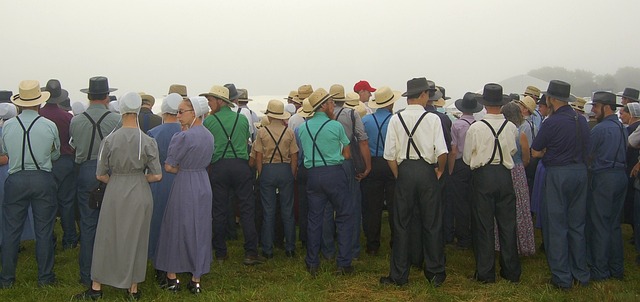The Amish community is known for its traditional and simple way of life, which often includes limited use of modern technology. This has led to questions about whether Amish children are allowed to have toys. In this article, we will explore whether or not Amish individuals can have toys as part of their lifestyle.
Table of Contents
The Importance of Play in Amish Children’s Development
Can Amish have toys? This is a question that often comes up when people think about the Amish community. Many people have a misconception that Amish children do not have any toys or playtime. However, this is far from the truth. Play is actually an essential part of Amish children’s development, just like it is for any other child.
Play is a universal language that all children understand, regardless of their cultural background. It is through play that children learn about the world around them, develop their imagination, and build important social and cognitive skills. The Amish community recognizes the importance of play in a child’s life and encourages it in various ways.
While it is true that Amish children do not have access to modern electronic toys or gadgets, they have a wide range of traditional toys that are designed to stimulate their creativity and imagination. These toys are often handmade by the Amish themselves, using natural materials such as wood and fabric. They are simple yet effective in providing hours of entertainment and learning opportunities for the children.
One of the most popular toys among Amish children is the wooden dollhouse. These dollhouses are meticulously crafted and often passed down from generation to generation. They provide a platform for children to engage in imaginative play, creating their own stories and scenarios. The dollhouse becomes a miniature world where children can explore different roles and relationships, fostering their social and emotional development.
Another favorite toy among Amish children is the wooden puzzle. These puzzles come in various shapes and sizes, challenging children to problem solve and develop their fine motor skills. They are not only fun to play with but also help children develop their cognitive abilities, such as spatial awareness and logical thinking.
Outdoor play is also highly encouraged in the Amish community. Amish children have access to open fields, gardens, and farms where they can run, jump, and explore nature. They engage in activities such as hide-and-seek, tag, and ball games, which not only promote physical fitness but also teach them important social skills such as cooperation, teamwork, and fair play.
In addition to traditional toys, Amish children also engage in practical play. They often help their parents with household chores, such as cooking, cleaning, and gardening. This type of play not only teaches them valuable life skills but also instills a sense of responsibility and work ethic from a young age.
It is important to note that the Amish community values simplicity and minimalism. They believe in living a life free from materialistic distractions. Therefore, while Amish children do have toys, they are often limited in number and focus on quality rather than quantity. This allows children to fully engage with their toys and derive maximum benefit from them.
In conclusion, play is an integral part of Amish children’s development. They may not have access to modern electronic toys, but they have a wide range of traditional toys that stimulate their creativity and imagination. From wooden dollhouses to puzzles, Amish children engage in play that fosters their social, cognitive, and emotional development. Outdoor play and practical play also play a significant role in their upbringing. So, the next time you wonder if Amish children can have toys, remember that play is an essential part of their lives, just like it is for any other child.
Traditional Amish Toys: A Look into their History and Significance

Can Amish have toys? This is a question that often comes to mind when thinking about the Amish community. Known for their simple and traditional way of life, it’s easy to assume that toys may not have a place in their world. However, a closer look into the history and significance of traditional Amish toys reveals a different story.
The Amish community, with its roots in 17th-century Europe, has always valued simplicity and humility. They believe in living a life that is separate from the modern world, focusing on faith, family, and community. This commitment to a simpler way of life extends to their choice of toys as well.
Traditional Amish toys are often handmade, using natural materials such as wood and fabric. These toys are designed to encourage creativity, imagination, and physical activity. They are often simple in design, without the bells and whistles commonly found in modern toys.
One of the most iconic Amish toys is the wooden dollhouse. These dollhouses are meticulously crafted by hand, with intricate details that showcase the skill and craftsmanship of the Amish people. They are often passed down through generations, becoming cherished family heirlooms.
Another popular Amish toy is the wooden puzzle. These puzzles are not only entertaining but also educational, helping children develop problem-solving skills and hand-eye coordination. The simplicity of these puzzles allows children to focus on the task at hand, without the distractions of lights and sounds.
Wooden blocks are also a staple in Amish toy collections. These blocks come in various shapes and sizes, allowing children to build and create to their heart’s content. The tactile nature of wooden blocks provides a sensory experience that is often lacking in plastic toys.
In addition to these traditional toys, the Amish also value outdoor play. Simple toys such as kites, jump ropes, and wooden scooters are popular among Amish children. These toys not only provide hours of fun but also encourage physical activity and a connection with nature.
The significance of traditional Amish toys goes beyond mere entertainment. These toys reflect the values and beliefs of the Amish community. By choosing simple and handmade toys, the Amish emphasize the importance of craftsmanship, resourcefulness, and sustainability. They teach children to appreciate the beauty of simplicity and to value the things that truly matter in life.
While the Amish community may not embrace the flashy and high-tech toys of the modern world, they have found a way to provide their children with toys that are both meaningful and enjoyable. Traditional Amish toys offer a glimpse into a simpler time, where imagination and creativity were the driving forces behind play.
So, can Amish have toys? Absolutely! But these toys are not just any toys. They are carefully chosen and crafted to align with the Amish way of life. They serve as a reminder of the values and traditions that have been passed down through generations. And most importantly, they bring joy and laughter to Amish children, just like any other toy would.
Balancing Technology and Tradition: Exploring Amish Toy Preferences
Can Amish have toys? It’s a question that many people may wonder about when they think of the Amish community. The Amish are known for their simple and traditional way of life, which often includes eschewing modern technology. But does this mean that they don’t have any toys to play with?
The answer is not as straightforward as a simple yes or no. While the Amish do prioritize simplicity and minimalism in their lifestyle, they do allow for some toys to be a part of their children’s lives. However, these toys are typically very different from what most people would consider “typical” toys.
One of the main reasons why the Amish limit the types of toys their children have is because they believe in fostering creativity and imagination. They want their children to learn how to entertain themselves without relying on external stimuli. This means that many Amish toys are handmade and encourage open-ended play.
Wooden toys are a popular choice among the Amish community. These toys are often crafted by hand using traditional woodworking techniques. They can range from simple blocks and puzzles to more intricate dollhouses and play kitchens. The emphasis is on the quality and craftsmanship of the toy rather than flashy lights or electronic features.
Another type of toy that Amish children often enjoy is outdoor play equipment. Swings, slides, and climbing structures are common in Amish communities. These types of toys allow children to engage in physical activity and enjoy the outdoors, which is an important part of Amish life.
In addition to wooden toys and outdoor play equipment, Amish children may also have dolls and stuffed animals. However, these toys are typically very basic and do not have all the bells and whistles that many mainstream toys have. The focus is on simplicity and encouraging imaginative play rather than providing entertainment through technology.
It’s important to note that the Amish do have guidelines and restrictions when it comes to toys. They generally avoid toys that promote violence or have a negative influence on their children’s behavior. This means that toys with guns, violent video games, or other aggressive themes are not typically found in Amish households.
While the Amish do limit the types of toys their children have, it’s not to say that they completely reject technology. In recent years, some Amish communities have started to embrace certain types of technology, such as solar power and cell phones. However, these advancements are carefully considered and implemented in a way that aligns with their values and beliefs.
In conclusion, while the Amish do prioritize simplicity and minimalism in their lifestyle, they do allow for some toys to be a part of their children’s lives. Wooden toys, outdoor play equipment, and basic dolls and stuffed animals are common in Amish households. The focus is on fostering creativity and imagination rather than relying on flashy lights or electronic features. The Amish also have guidelines and restrictions when it comes to toys, avoiding those that promote violence or have a negative influence on their children’s behavior. Ultimately, the Amish strike a balance between tradition and technology, ensuring that their children have toys that align with their values and beliefs.
Amish Toy-Making: A Craft Passed Down Through Generations
Can Amish have toys? This is a question that often comes to mind when thinking about the Amish community. Known for their simple and traditional way of life, it may seem like toys would be out of place in their world. However, the truth is that Amish children do have toys, but they are not the same as the ones you might find in a typical toy store.
Amish toy-making is a craft that has been passed down through generations. It is a skill that is taught to children from a young age, allowing them to develop their creativity and craftsmanship. These toys are often made from wood, reflecting the Amish commitment to simplicity and natural materials.
One of the most popular Amish toys is the wooden dollhouse. These dollhouses are meticulously crafted, with intricate details and beautiful finishes. They are often made to scale, with multiple rooms and even miniature furniture. These dollhouses provide hours of imaginative play for Amish children, allowing them to create their own little world.
Another popular Amish toy is the wooden puzzle. These puzzles are not your typical jigsaw puzzles, but rather three-dimensional puzzles that require problem-solving skills. They come in various shapes and sizes, from simple geometric shapes to more complex designs. These puzzles not only provide entertainment but also help develop cognitive skills and hand-eye coordination.
Wooden blocks are also a staple in Amish toy-making. These blocks come in different sizes and shapes, allowing children to build and create to their heart’s content. They can be stacked, sorted, and arranged in various ways, fostering creativity and spatial awareness. These blocks are often passed down from generation to generation, becoming cherished family heirlooms.
In addition to these traditional toys, Amish children also enjoy outdoor play. Simple games like tag, hide-and-seek, and jump rope are popular among Amish children. They also enjoy playing with handmade wooden toys such as wagons, scooters, and rocking horses. These toys not only provide entertainment but also encourage physical activity and outdoor exploration.
Amish toy-making is not just a hobby; it is a way of life. The craftsmanship and attention to detail that goes into making these toys are a reflection of the Amish values of simplicity, hard work, and quality. Each toy is made with love and care, ensuring that it will last for generations to come.
While Amish children do have toys, it is important to note that their toys are not focused on technology or commercialism. Instead, they are designed to encourage creativity, imagination, and hands-on play. These toys allow Amish children to engage with the world around them in a meaningful and wholesome way.
So, can Amish have toys? Absolutely! Amish toy-making is a cherished tradition that has been passed down through generations. These toys provide hours of entertainment, foster creativity and imagination, and reflect the values of the Amish community. While they may be different from the toys we are accustomed to, they are a testament to the beauty and simplicity of Amish life.
Conclusion
Yes, Amish children can have toys.
For licensing reasons, we must provide the following notice: This content was created in part with the help of an AI.



